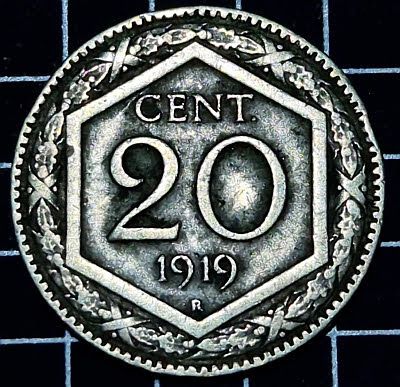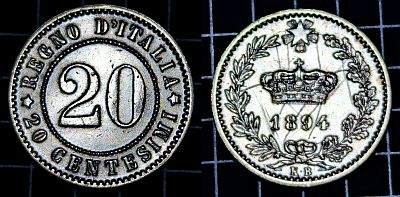A re-used coin from the Kingdom of Italy
The Kingdom of Italy
In talking about one of the last Papal States coins, we had a bit of a look at the make-up of Italy in the mid-19th century. Broadly there were three kingdoms (Sardinia, Lombardy-Ventia and the Kingdom of the two Sicilies), three sovereign duchies, and the extensive temporal possessions of the papacy – the Papal States. Following a series of European Revolutions of 1848, and a rise of Italian nationalists and monarchists loyal to the House of Savoy, the Kingdom of Italy was established in 1860. King Victor Emmanuel II of Savoy was declared King of Italy. This title had been used previously by Napoleon in 1805, although at that time Napoleon only controlled Lombardy and the Emilia Romagna. As previously noted, in 1870, Victor Emmanuel II completed his kingdom by invading the Vatican. Victor Emmanuel II passed in 1878, and is still remembered as the first King of Italy. He was succeeded by his son Umberto I, and then in 1900 by Umberto’s son Victor Emmanuel III.
Seen in retrospect as “The Fascist King”, Victor Emmanuel III ruled during both World War I and World War II and participated in the rise and fall of Italian Fascism. His support for Benito Mussolini tainted the image of the Italian monarchy. This led to the eventual abolition of the monarchy in 1946, following Italy’s defeat as part of the Axis powers of WWII.
Obverse

The obverse features the Crowned Savoia Shield between twisted branches of laurel and oak, the issuer name above, and the engraver’s initials below. The issuer name “Regno D’Italia” translates as “Kingdom of Italy”. Be aware if you search on Numista for “Regno D’Italia” it finds 39 results, of which the first 11 are from Napoleon’s time. A search for “D’Italia” finds 93, of which 27 are from places or times other than the Kingdom of Italy but does find the Kingdom coins together.
Reverse

The reverse of the coin features the value and date of the coin within a hexagon surrounded by a laurel wreath and the mintmark below the date. The “R” mintmark denotes the mint in Rome. In 1870, with Rome as the capital of the new Kingdom of Italy, the mints of the pre-unification states disappear, and the Papal Mint becomes Royal Mint. Later on, in 1978, it will go on to merge with the “Istituto Poligrafico dello Stato”. The new entity still trades today as “Istituto Poligrafico e Zecca dello Stato“.
I do find coins with a different shape around much of the inside interesting. In this case a hexagon on a round coin. We have also looked at an Indian coin with a scalloped edge but a shape in the centre… I actually didn’t try to describe, but it was one thing which drew my eye to the coin in the first place.
On this particular coin, although not mentioned in the Numista description, and it might just be my reading this into it, but the way the wreath is tied strongly reminds me of a “Fasces”. We’ve encountered fasces before in this French Vichy coin. The Fasces had been used since ancient times (see the summary in that Vichy coin piece) and was adopted as a symbol of fascism. Here is a representation on an earlier Italian gold coin which particularly reminds me of the style of tying of the wreath on today’s coin:

(1798 Genoa 12 Lire coin, from Numista)
Counterstamp
Stepping back to the time of this coin, at the outbreak of WWI, Italy originally remained neutral. Italy initially remained neutral. Most of the government opposed entering the war, but Victor Emmanuel ignored their protests. He hoped to gain territory from Austria-Hungary, but corruption and disorganization led the Italian Army into defeat. Following the war, Italy suffered from an economic depression that led to a rise of more political instability and extremism.
In 1918, with the Great War still going, nickel was very precious for military industries. To conserve the nickel, previous 20 centesimos coins (km# 28) were withdrawn from circulation as base metal to overstrike these new coins.

(An 1894 20 Centesimi, KM# 28. Interestingly my example is quite scratched on one side – possibly deliberately defaced? – around the crown)
Many coins have signs of the design of the previous km# 28. The edge of the coin, which should be smooth on this piece, is partly reeded, again showing through from the earlier coin. Coins with more of the early design clearly showing through are considered more valuable. Interestingly, unlike the Brazilian 40 Réis over 80 Réis, this time the counterstamp was not to revalue the coin, just to re-use the metal.
I was curious about that, and asked on Numista Forums. Master_of_Coins suggested the answer may have had several reasons:
- KM28 was demonetised in 1909, so a new law would need to be made to re-monetize them.
- The government had the majority of the withdrawn pieces, however there were still a significant number, almost 11.4 million, unaccounted for, hidden in drawers, pockets or simply hoarded. These coins, with a face value of 2.28 million Lira had an equivalent value of over 4 Million Euro today (adjusted for inflation).
- Each time the government mints a fiat coin, it has a face value higher than its production cost. The income the government makes from minting coins is called “seigniorage”.
- If the old coins were simply remonetised as they were, the government would miss out on that seigniorage.
- But, if they made new coins from scratch, they would have to buy the metal, create the blanks etc. Instead, they already had 77 million of the old KM #28 coins they could use.
- Master of Coins also notes that the older coins were easy to fake. I’m not sure whether these newer coins had any security measures to overcome this, or whether it was simply that it took longer for counterfeiters to start production of a new coin back then, so wouldn’t be an issue immediately?
- And it’s always possible someone in charge wanted to give a job to the mint so it wouldn’t sit idle, perhaps in return for a favour (all speculation).
Thanks Master of Coins for sharing that insight!

Only a hint of the original reeding remains on my example. What is your favourite modified / re-issued or altered coin? Do let us know!


Leave a Reply